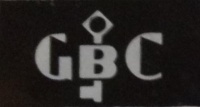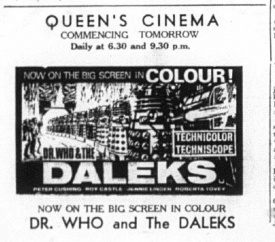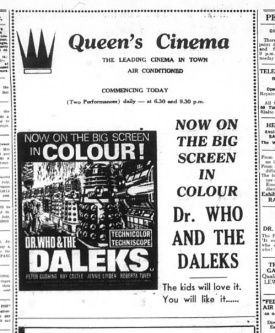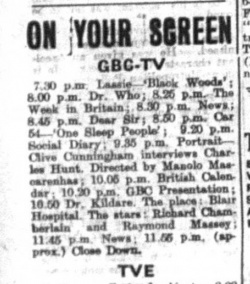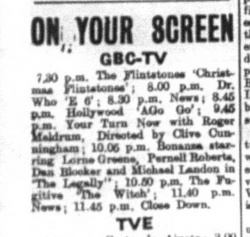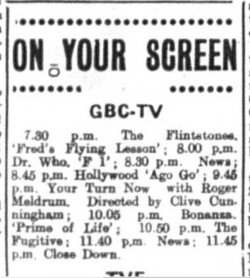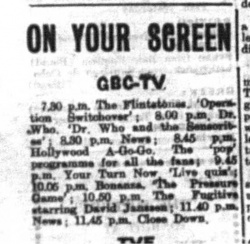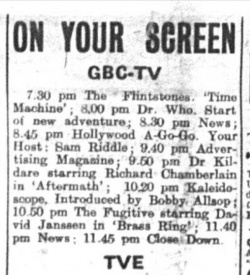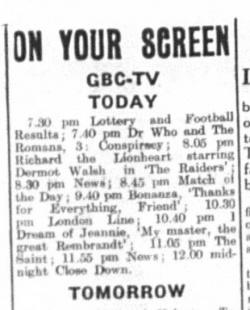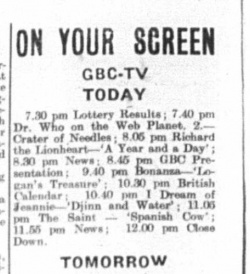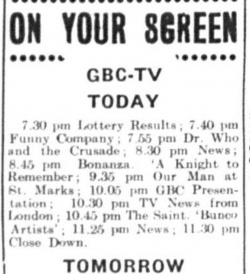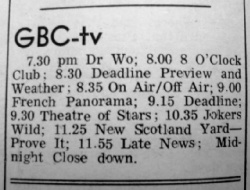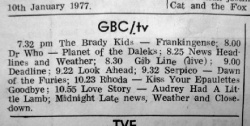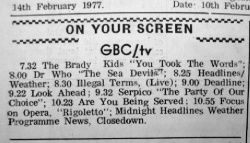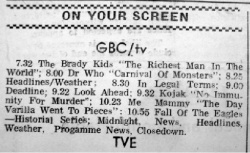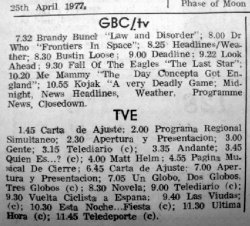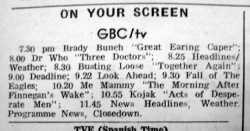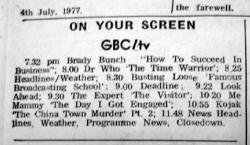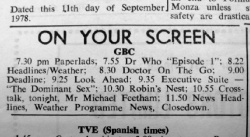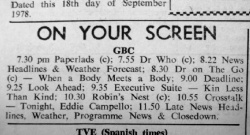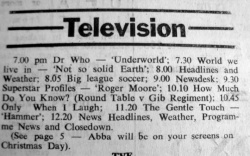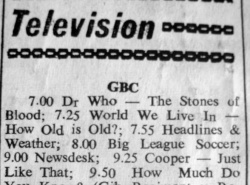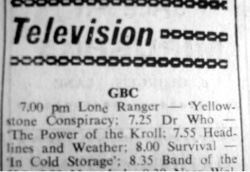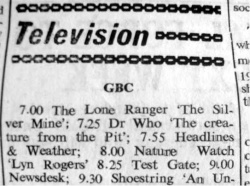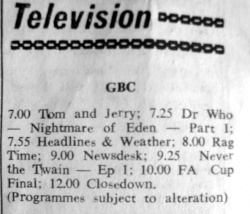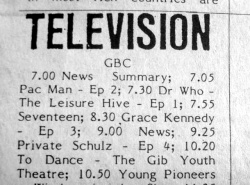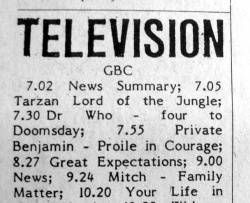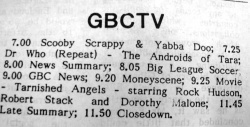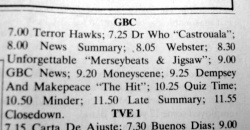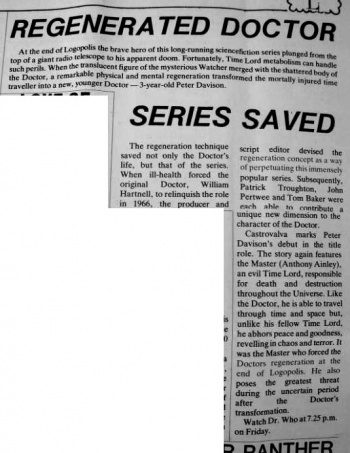Difference between revisions of "Gibraltar"
Jon Preddle (talk | contribs) |
Jon Preddle (talk | contribs) |
||
| (54 intermediate revisions by the same user not shown) | |||
| Line 1: | Line 1: | ||
'''[[Wikipedia:Gibraltar|GIBRALTAR]]''' lies at the mouth of the Mediterranean Sea, on a peninsula to the south of [[Spain]]. | '''[[Wikipedia:Gibraltar|GIBRALTAR]]''' lies at the mouth of the Mediterranean Sea, on a peninsula to the south of [[Spain]]. | ||
{{TOC right}} | {{TOC right}} | ||
| − | ==Profile== | + | ==Profile== |
{| {{small-table}} | {| {{small-table}} | ||
|- | |- | ||
| Line 21: | Line 21: | ||
==Television Stations / Channels== | ==Television Stations / Channels== | ||
| − | + | [[File:GBClogo.JPG|left|200px]] | |
Gibraltar began its television service in 1962. There is just one television station: '''[[wikipedia: Gibraltar Broadcasting Corporation| Gibraltar Broadcasting Corporation (GBC-TV)]]''', a government-owned commercial broadcaster. | Gibraltar began its television service in 1962. There is just one television station: '''[[wikipedia: Gibraltar Broadcasting Corporation| Gibraltar Broadcasting Corporation (GBC-TV)]]''', a government-owned commercial broadcaster. | ||
| − | + | Limited colour transmissions began in 1969 using the [[Wikipedia:PAL|PAL]] colour broadcast system. In 1980, the GBC moved to brand new premises, a purpose-built facility designed for full colour broadcasts. (The new facility would not have catered for broadcast from or long-term storage of film.) | |
| − | While the principal language of Gibraltar is English, Gibraltans could also receive broadcasts from the Spanish television station, '''Televisión Española ( | + | While the principal language of Gibraltar is English, Gibraltans could also receive broadcasts from the Spanish television station, '''Televisión Española ([[wikipedia:TVE|TVE]])'''; the newspapers often carried TV listings for that channel. |
| Line 32: | Line 32: | ||
Gibraltar was the '''5th''' country to screen '''Doctor Who'''; it was the '''first''' in Europe (see [[Selling Doctor Who]]). | Gibraltar was the '''5th''' country to screen '''Doctor Who'''; it was the '''first''' in Europe (see [[Selling Doctor Who]]). | ||
| + | |||
| + | |||
| + | ==DALEK MOVIES== | ||
| + | ===[[Peter Cushing|PETER CUSHING]] Movies=== | ||
| + | The first [[Peter Cushing]] Dalek film, '''"Dr Who and the Daleks"''' (U certificate) commenced its four day run at the Queen's Cinema, '''2 to 5 July 1966''', with sessions at 6.30 and 9.30pm daily. [[The Web Planet]] was on TV at the time – see below. | ||
| + | <table> | ||
| + | <tr> | ||
| + | <td>[[File:GIB DATDs1.JPG|thumb|275px|Dr Who and the Daleks "commencing tomorrow" (1 July 1966)]]</td> | ||
| + | <td>[[File:GIB DATDs2.JPG|thumb|275px|Dr Who and the Daleks "commencing today" (2 July 1966)]]</td> | ||
| + | <td>[[File:GIB DATDs3.JPG|thumb|150px|Film Review, 4 July 1966]]</td> | ||
| + | </tr> | ||
| + | </table> | ||
| + | The film was announced as "commencing tomorrow" in the Friday, '''1 July 1966''' edition of the ''Gibraltar Chronicle''. The Monday, '''4 July''' issue had a review of the film, calling it "derivative" but that "children will probably adore it". | ||
| + | |||
| + | It's not known if/when the sequel was shown in Gibraltar. | ||
| + | |||
| + | |||
==[[BBC Records]]== | ==[[BBC Records]]== | ||
| − | The '''Stanmark Productions Ltd''' advertisement from 1966, identifies Gibraltar as one ''' | + | The '''Stanmark Productions Ltd''' advertisement from 1966, identifies Gibraltar as one of the '''sixteen''' countries screening '''Doctor Who''' by January 1966. |
| + | |||
| + | Gibraltar is named in the list of 27 countries in '''The Making of Doctor Who''' 1972 Piccolo edition. | ||
'''The Seventies''' records a sale of '''"(26)"''' stories by 28 February 1977. '''The Handbook''' identifies 16 of these as being: {{M}}, {{P}}, {{R}}, {{S}}, {{NN}}, {{OO}}, {{QQ}}, {{RR}}, {{SS}}, {{TT}}, {{UU}}, {{VV}}, {{WW}}, {{XX}}, {{YY}}, {{ZZ}}. The remaining 10 are Pertwees. | '''The Seventies''' records a sale of '''"(26)"''' stories by 28 February 1977. '''The Handbook''' identifies 16 of these as being: {{M}}, {{P}}, {{R}}, {{S}}, {{NN}}, {{OO}}, {{QQ}}, {{RR}}, {{SS}}, {{TT}}, {{UU}}, {{VV}}, {{WW}}, {{XX}}, {{YY}}, {{ZZ}}. The remaining 10 are Pertwees. | ||
| − | '''The Eighties''' [http://www.shillpages.com/howe/b-dw80s.htm - THE LOST CHAPTERS] records a sale of '''"(44)"''' stories (by 10 February 1987). This total includes the same 10 Pertwees from the 1977 list, plus an additional 34 stories. | + | '''The Eighties''' [http://www.shillpages.com/howe/b-dw80s.htm - THE LOST CHAPTERS] records a sale of '''"(44)"''' stories (by 10 February 1987). This total probably includes the same 10 Pertwees from the 1977 list, plus an additional 34 stories. This could be three more Pertwees, seven Davisons, and 24 Bakers... OR just three Pertwees, seven Davisons and 34 Bakers… |
In '''DWM''', sales to Gibraltar are identified in '''38''' story Archives: the above 16, plus an additional 22: {{A}}, {{C}}, {{N}}, {{Q}}, {{PP}}, {{AAA}}, {{BBB}}, {{CCC}}, {{EEE}}, {{GGG}}, {{HHH}}, {{KKK}}, {{MMM}}, {{LLL}}, {{OOO}}, {{QQQ}}, {{SSS}}, {{UUU}}, {{4A}}, {{4C}}, {{4B}}, and {{4D}}. These sales span 1965 to 1978. | In '''DWM''', sales to Gibraltar are identified in '''38''' story Archives: the above 16, plus an additional 22: {{A}}, {{C}}, {{N}}, {{Q}}, {{PP}}, {{AAA}}, {{BBB}}, {{CCC}}, {{EEE}}, {{GGG}}, {{HHH}}, {{KKK}}, {{MMM}}, {{LLL}}, {{OOO}}, {{QQQ}}, {{SSS}}, {{UUU}}, {{4A}}, {{4C}}, {{4B}}, and {{4D}}. These sales span 1965 to 1978. | ||
| + | |||
==Stories bought and broadcast== | ==Stories bought and broadcast== | ||
===[[William Hartnell stories|WILLIAM HARTNELL]]=== | ===[[William Hartnell stories|WILLIAM HARTNELL]]=== | ||
| − | + | [[File:GBC gen 1960s.JPG|right|thumb|250px|"Dr Who", first episode; Gibraltar Chronicle, 8 April 1965]] | |
| − | + | [[File:GBC DE E6.JPG|right|thumb|250px|"E6" – Keys of Marinus, 5 October 1965]] | |
| + | [[File:GBC DW F1.JPG|right|thumb|250px|"F1" – The Aztecs, 12 October 1965]] | ||
| + | [[File:GBC Sensorites.JPG|right|thumb|250px|The Sensorites part 1, 9 November 1965]] | ||
| + | [[File:GBC new ad.JPG|right|thumb|250px|"New Adventure" (Planet of Giants), 1 February 1966]] | ||
| + | [[File:GBC Romans 3.JPG|right|thumb|250px|"The Romans 3: Conspiracy"; 14 May 1966]] | ||
{| {{small-table}} | {| {{small-table}} | ||
| Line 93: | Line 117: | ||
====Origin of the Prints?==== | ====Origin of the Prints?==== | ||
| − | Gibraltar was the first country in [[:Category:Europe|Europe]] to screen the series, so it would have been supplied with brand new prints from its distributor, which was [[ | + | Gibraltar was the first country outside the UK in [[:Category:Europe|Europe]] to screen the series, so it would have been supplied with brand new prints from its distributor, which was '''[[TIE Ltd|Television International Enterprises Ltd / TIE (Programmes) Ltd)]]'''. |
| Line 101: | Line 125: | ||
{| {{small-table}} | {| {{small-table}} | ||
| − | |||
| − | |||
|- | |- | ||
|UU||[[The Mind Robber]]||5 | |UU||[[The Mind Robber]]||5 | ||
| Line 115: | Line 137: | ||
|- | |- | ||
|ZZ||[[The War Games]]||10 | |ZZ||[[The War Games]]||10 | ||
| + | |- | ||
| + | | | ||
|- | |- | ||
|NN||[[The Abominable Snowmen]]||6 | |NN||[[The Abominable Snowmen]]||6 | ||
| Line 127: | Line 151: | ||
|- | |- | ||
|SS||[[The Wheel in Space]]||6 | |SS||[[The Wheel in Space]]||6 | ||
| + | |- | ||
| + | |TT||[[The Dominators]]||5 | ||
|- | |- | ||
|} | |} | ||
Gibraltar therefore bought GROUP D, E and F of the [[Patrick Troughton stories]], albeit out of order. | Gibraltar therefore bought GROUP D, E and F of the [[Patrick Troughton stories]], albeit out of order. | ||
| + | |||
| + | It had been six years since the GBC had aired [[The Time Meddler]]. For it to pick up the series again starting with season six is very odd -- but it's very likely that the GBC was offered these episodes because [[New Zealand]] had turned them down (because it was due to launch colour in late 1973 and didn't want more black and white programmes). | ||
| + | |||
| + | After screening season six and the first three Pertwee serials, the GBC was offered some earlier Troughton episodes, which is why they got season five a year later on "back catalogue". | ||
The programme was supplied as 16mm black and white film prints with English soundtracks. | The programme was supplied as 16mm black and white film prints with English soundtracks. | ||
====Origin of the Prints?==== | ====Origin of the Prints?==== | ||
| − | The | + | The prints either came directly from the BBC (and it's possible the season six film prints were ones originally struck for but not bought by [[New Zealand]]), or they were bicycled in from [[Singapore]]. Or maybe a combination of the two - only some prints had been struck in anticipation for New Zealand, and the rest came from [[Singapore]]? |
| + | |||
| + | If the films were sent from [[Singapore]] to the BBC first (in 1970/71), it's possible that part 3 of [[The Wheel in Space]] and part 5 of [[The Dominators]] were lost or damaged (or stolen), and replacements were struck before being sent to Gibraltar in 1973. (These two episodes fell into the hands of a number of collectors, and they were returned to the BBC in 1983…) | ||
| + | |||
| + | Since [[The Dominators]] wasn't sold with the rest of season six in 1972, but with season five in early 1973, this may be due to part 5 having 'gone astray'; it wasn't until a new print could be struck (along with [[The Wheel in Space]] part 3) that it could be dispatched to Gibraltar. | ||
| + | |||
| + | As we've noted on the [[Nigeria]] profile, it's possible that Gibraltar lent its prints of [[The Wheel in Space]] to MidWest, who aired them first in early 1973, then returned them in time for Gibraltar to air them in late 1973. Alternatively, the films were sent by the BBC to [[Nigeria]] first and then to Gibraltar. | ||
| + | |||
| + | Alternatively, all were struck afresh for the sale to Gibraltar (perhaps for the purposes of establishing a new Bicycling system for Africa?). | ||
| + | |||
===[[Jon Pertwee stories|JON PERTWEE]]=== | ===[[Jon Pertwee stories|JON PERTWEE]]=== | ||
Sixteen stories, 82 episodes, some of which aired out of order: | Sixteen stories, 82 episodes, some of which aired out of order: | ||
| − | |||
{| {{small-table}} | {| {{small-table}} | ||
|- | |- | ||
| Line 177: | Line 215: | ||
|} | |} | ||
| − | Gibraltar therefore bought parts of GROUPs A, B, C, D and E of the [[Jon Pertwee stories]]. | + | Gibraltar therefore bought parts of GROUPs A, B, C, D and E of the [[Jon Pertwee stories]]. Four of the stories not sold – {{DDD}}, {{FFF}}, {{JJJ}} and {{TTT}} - were not available to Commonwealth countries, due to the censorship problems in [[Australia]]. Gibraltar also did not screen the bulk of season 11, which was available only on PAL video tapes. |
This may seem odd, after all, the GBC had been broadcasting colour since 1969 – however it is more than likely that colour transmissions were from film only; the broadcaster was not geared up for transmitting from video tape until late 1977/early 1978, in time to screen [[Tom Baker stories]]. | This may seem odd, after all, the GBC had been broadcasting colour since 1969 – however it is more than likely that colour transmissions were from film only; the broadcaster was not geared up for transmitting from video tape until late 1977/early 1978, in time to screen [[Tom Baker stories]]. | ||
| − | The TV listings during the Pertwee runs often included those for TVE in Spain – and these listings often included a '''(c)''' symbol, which indicated '''colour'''. | + | The TV listings during the Pertwee runs often included those for TVE in Spain – and these listings often included a '''(c)''' symbol, which indicated '''colour'''. The fact that none of the Gibraltar listings for '''Doctor Who''' are noted as being colour, does support that they were all in black and white up until 1978. |
The programme was supplied as 16mm black and white film prints with English soundtracks. | The programme was supplied as 16mm black and white film prints with English soundtracks. | ||
====Origin of the Prints?==== | ====Origin of the Prints?==== | ||
| − | The Pertwees | + | The first three Pertwees were likely supplied by the BBC directly (and could be prints originally struck for but not purchased by [[New Zealand]]), or they were bicycled over from [[Singapore]]. |
| + | |||
| + | Seasons eight and nine were also likely supplied by [[Singapore]]. The delayed [[The Sea Devils]], the season ten serials plus [[The Time Warrior]] were all most likely provided by [[Australia]]. | ||
===[[Tom Baker stories|TOM BAKER]]=== | ===[[Tom Baker stories|TOM BAKER]]=== | ||
| − | Seventeen identified stories, | + | Seventeen identified stories, 70 episodes: |
| − | |||
{| {{small-table}} | {| {{small-table}} | ||
| Line 202: | Line 241: | ||
|4C||[[The Ark in Space]]||4 | |4C||[[The Ark in Space]]||4 | ||
|- | |- | ||
| − | | | + | |4E||[[Genesis of the Daleks]]||6 |
|- | |- | ||
| − | | | + | |||several unknown stories||32 (*) |
|- | |- | ||
|4Y||[[Underworld]]||4 | |4Y||[[Underworld]]||4 | ||
| Line 237: | Line 276: | ||
The programme was supplied as PAL colour video tapes with English soundtracks. | The programme was supplied as PAL colour video tapes with English soundtracks. | ||
| + | |||
| + | (*) There are 32 unnamed episodes in the newspapers. This is made up of two 6-parters and five 4-parters, so seven stories in total. That's 25 Tom Bakers accounted for. Two stories from season 17, and the last four from season 18 were skipped, which leaves 10 others not accounted for. 25 plus 10 = 35, plus seven Davisons is 42, two short of the "44" recoded on BBC records. (Anecdotal evidence suggests there were more Bakers to screen than we've accounted for – the reasons for this are covered below.) | ||
| + | |||
| + | On that basis, those marked # might be the unnamed stories that fill the 32 airdates that have been found, and those marked * may have aired in 1979: | ||
| + | |||
| + | {| {{small-table}} | ||
| + | |- | ||
| + | |4D||[[Revenge of the Cybermen]] *||4 | ||
| + | |- | ||
| + | |4F||[[Terror of the Zygons]] *||4 | ||
| + | |- | ||
| + | |4G||[[Pyramids of Mars]] *||4 | ||
| + | |- | ||
| + | |4H||[[Planet of Evil]] *||4 | ||
| + | |- | ||
| + | |4J||[[The Android Invasion]] *||4 | ||
| + | |- | ||
| + | |4K||[[The Brain of Morbius]] *||4 | ||
| + | |- | ||
| + | |4L||[[The Seeds of Doom]] *||6 | ||
| + | |- | ||
| + | |4M||[[The Masque of Mandragora]] *||4 | ||
| + | |- | ||
| + | |4N||[[The Hand of Fear]] *||4 | ||
| + | |- | ||
| + | |4P||[[The Deadly Assassin]] *||4 | ||
| + | |- | ||
| + | |4Q||[[The Face of Evil]] *||4 | ||
| + | |- | ||
| + | |4R||[[The Robots of Death]] #||4 | ||
| + | |- | ||
| + | |4S||[[The Talons of Weng-Chiang]] #||6 | ||
| + | |- | ||
| + | |4V||[[Horror of Fang Rock]] #||4 | ||
| + | |- | ||
| + | |4T||[[The Invisible Enemy]] #||4 | ||
| + | |- | ||
| + | |4X||[[Image of the Fendahl]] #||4 | ||
| + | |- | ||
| + | |4W||[[The Sun Makers]] #||4 | ||
| + | |- | ||
| + | |4Z||[[The Invasion of Time]] #||6 | ||
| + | |- | ||
| + | |} | ||
| + | |||
| + | Gibraltar did skip some stories from season 17, so there is the possibility that some of these were also skipped. Remember, there are "44" stories sold to be accounted for… | ||
| Line 265: | Line 350: | ||
The programme was supplied as PAL colour video tapes with English soundtracks. | The programme was supplied as PAL colour video tapes with English soundtracks. | ||
| − | |||
| − | |||
| − | |||
| − | |||
| − | |||
| − | |||
| − | |||
==Transmission== | ==Transmission== | ||
| + | [[File:GBC Web Planet 2.JPG|right|thumb|250px|"…on the Web Planet 2: Crater of Needles" [sic] (should be "The Zarbi"); 4 June 1966 (Note Richard the Lionheart is on afterwards)]] | ||
| + | [[File:GBC Crusade.JPG|right|thumb|250px|The Crusade; 9 July 1966 (Note Richard the Lionheart is no longer screening!)]] | ||
| + | [[File:Gib DW.JPG|thumb|right|250px|Dr Who, generic untitled 1970s listing, Gibraltar Chronicle]] | ||
| + | [[File:Gib WO.JPG|thumb|right|250px|Dr Wo – Dr Who?, 17 September 1973]] | ||
| + | Seventeen stories, 81 episodes: | ||
===[[William Hartnell stories|WILLIAM HARTNELL]]=== | ===[[William Hartnell stories|WILLIAM HARTNELL]]=== | ||
| + | The series started on Thursday, '''8 April 1965''', at 8.00pm. With the third episode, the series moved to Tuesdays, at 7.50pm. From '''5 March 1966''' it moved to Saturdays, at 7.40pm, where it remained for the rest of the run, which finished on '''12 November 1966''' -- after 19 continuous months! | ||
| − | + | There are '''84''' weeks on which the series is listed, but only '''81''' episodes to account for, so presumably three episodes were pre-empted. One of these extra dates appears to have been '''30 July 1966''', as there are '''five''' listings for [[The Crusade]]. It's possible the other two pre-emptions occurred when the day of the week changed. | |
| − | + | '''Doctor Who''' would not return to GBC for another '''five years'''… | |
Ironically, the programme that followed '''Doctor Who''' during much of this run was the ITV series '''"Richard the Lionheart"''', which played its final episode, '''"The People's King"''', on '''2 July 1966''', the week before the '''Doctor Who''' serial [[The Crusade]] aired! | Ironically, the programme that followed '''Doctor Who''' during much of this run was the ITV series '''"Richard the Lionheart"''', which played its final episode, '''"The People's King"''', on '''2 July 1966''', the week before the '''Doctor Who''' serial [[The Crusade]] aired! | ||
| − | + | As noted above, the [[Peter Cushing]] film, '''"Dr Who and the Daleks"''' (U certificate) commenced its four day run at the Queen's Cinema, '''2 to 5 July 1966''', with sessions at 6.30 and 9.30pm daily. [[The Web Planet]] was on TV at the time. | |
| + | |||
| + | ====Fate of the Prints?==== | ||
| + | |||
| + | Gibraltar most likely sent its prints of the first eleven stories to [[Aden]], which was the next country in the [[TIE Ltd]] distribution network to screen the series (starting in July 1965). | ||
| + | |||
| + | The remaining season two serials probably went to [[Zambia]]. | ||
| + | (The GBC moved to its new colour TV centre in 1980; it's likely that any black and white films prints still held would have been disposed of at the time of the relocation.) | ||
| − | + | <!--Gibraltar had screened (and sent?) [[Marco Polo]] by the time the series debuted (delayed by a couple of weeks) in [[Rhodesia]]. But the trade sanctions imposed on [[Rhodesia]] in February 1966 may have prevented Gibraltar from supplying any more episodes; in which case the prints of the subsequent episodes may have by-passed [[Rhodesia]] and gone to [[Zambia]] instead.--> | |
| − | + | . | |
---- | ---- | ||
| Line 294: | Line 385: | ||
===[[Patrick Troughton stories|PATRICK TROUGHTON]]=== | ===[[Patrick Troughton stories|PATRICK TROUGHTON]]=== | ||
| − | + | After a log gap of five years and three months, '''Doctor Who''' returned – on Monday, '''14 February 1972''', at 8.00pm – but with an entirely new Doctor. If BBC records are accurate, the first serial to air was the season six Patrick Troughton story, [[The Mind Robber]]. (Gibraltar viewers had therefore completely missed out on all of seasons three to five.) | |
| − | + | For one week only, the series shifted to Tuesday, '''25 April''' – for part six of [[The Invasion]]. | |
| + | 39 weeks later, on '''6 November 1972''', viewers saw the Doctor exiled to Earth... | ||
| − | + | . | |
| − | |||
| − | |||
---- | ---- | ||
===[[Jon Pertwee stories|JON PERTWEE]]=== | ===[[Jon Pertwee stories|JON PERTWEE]]=== | ||
| + | [[File:Gib SSS.JPG|thumb|right|250px|Planet of the Daleks, part one, 11 January 1977]] | ||
| + | [[File:Gib LLL.JPG|thumb|right|250px|The Sea Devils, part one, 15 February 1977]] | ||
| + | [[File:Gib PPP.JPG|thumb|right|250px|Carnival of Monsters, part one, 29 March 1977]] | ||
| + | [[File:Gib QQQ.JPG|thumb|right|250px|Frontiers in Space, part one, 26 April 1977 – note TVE billings in colour]] | ||
| + | [[File:Gib RRR.JPG|thumb|right|250px|The Three Doctors, part one, 14 June 1977]] | ||
| + | [[File:Gib UUU.JPG|thumb|right|250px|The Time Warrior, part one, 5 July 1977 – the last black and white story to screen in Gibraltar]] | ||
| + | The week following, on Monday, '''13 November 1972''', the Pertwee era commenced, at 8.00pm. The third episode of [[Doctor Who and the Silurians]] was moved to 26 December, to allow for the Christmas Day schedules. The run of 18 episodes from Pertwees first season ended on '''12 March 1973'''. | ||
| − | + | ([[Inferno]] did not screen, due to censorship problems with the serial in [[Australia]], an issue which affected all sales of that serial to other Commonwealth territories.) | |
| − | + | . | |
---- | ---- | ||
| Line 315: | Line 412: | ||
===[[Patrick Troughton stories|PATRICK TROUGHTON]] (continued)=== | ===[[Patrick Troughton stories|PATRICK TROUGHTON]] (continued)=== | ||
| − | The week following part seven of [[The Ambassadors of Death]], viewers saw the return of Patrick Troughton as the Doctor! | + | The week following part seven of [[The Ambassadors of Death]], viewers saw the return of Patrick Troughton as the Doctor! But this time GBC jumped back to the previously-skipped season five. Starting with [[The Abominable Snowmen]], this run of six 6-parters and one 5-parter played over a period of 41 weeks, from Monday, '''19 March 1973''', with a shift to Saturdays from '''20 October 1973''' with [[The Wheel in Space]] part two. The final Troughton episode to air was part five of [[The Dominators]] on '''22 December 1973'''. |
The timeslot changed several times, from 8.00pm, to 7.30pm, to 7.04pm. | The timeslot changed several times, from 8.00pm, to 7.30pm, to 7.04pm. | ||
| + | |||
| + | ====Fate of the Prints?==== | ||
| + | |||
| + | The first four season five serials probably went to [[Zambia]] soon after broadcast. | ||
| + | |||
| + | Gibraltar was the last ever country to screen [[Fury from the Deep]], [[The Mind Robber]] and [[The Invasion]] and possibly also [[The Wheel in Space]] in the 1970s. | ||
| + | |||
| + | All the Troughton stories not sent to [[Zambia]] were probably junked or returned to the BBC. (The GBC moved to its new colour TV centre in 1980; it's likely that any black and white films prints still held would have been disposed of at the time of the relocation.) | ||
| + | |||
| + | There's a very high likelihood that the small batch of random episodes from season six still held in 1978 came from the GBC. Indeed, the six existing prints of [[The Invasion]] may have come from Gibraltar. | ||
| + | |||
| + | |||
---- | ---- | ||
| Line 323: | Line 432: | ||
===[[Jon Pertwee stories|JON PERTWEE]] (continued)=== | ===[[Jon Pertwee stories|JON PERTWEE]] (continued)=== | ||
| − | One week later, the final week of 1973, saw the return of Jon Pertwee, at 7.06pm. | + | One week later, in the final week of 1973, viewers saw the return of Jon Pertwee, at 7.06pm. Picking up from where the previous run of third Doctor adventures had left off, the new run opened with [[Terror of the Autons]], on '''29 December 1973'''. |
This run lasted for 34 weeks, taking the series to the end of season 9, with [[The Time Monster]] on '''15 August 1974'''. | This run lasted for 34 weeks, taking the series to the end of season 9, with [[The Time Monster]] on '''15 August 1974'''. | ||
| Line 329: | Line 438: | ||
As before, two stories ([[The Mind of Evil]] and [[The Daemons]]) did not air, due to censorship issues in [[Australia]]. Also skipped at this time was [[The Sea Devils]], but unlike the other two serials, this would be scheduled for screening at a later time... | As before, two stories ([[The Mind of Evil]] and [[The Daemons]]) did not air, due to censorship issues in [[Australia]]. Also skipped at this time was [[The Sea Devils]], but unlike the other two serials, this would be scheduled for screening at a later time... | ||
| − | By this time, viewers had enjoyed a non-stop run of '''132''' episodes, over a 30 month period, | + | By this time, viewers had enjoyed a non-stop run of '''132''' episodes, over a 30 month period, starting with Troughton who turned into Pertwee, then back to Troughton, and back to Pertwee! |
Two and a half years later, on '''4 January 1977''', the GBC recommenced the series, on Tuesdays, at 8.00pm. This was a 30 week run, that ended on '''26 July 1977'''. | Two and a half years later, on '''4 January 1977''', the GBC recommenced the series, on Tuesdays, at 8.00pm. This was a 30 week run, that ended on '''26 July 1977'''. | ||
| − | Although GBC-TV could transmit in colour, these episodes were still in black and white. (By late 1975, the BBC had wiped the colour video tapes of [[Frontier in Space]] and [[Planet of the Daleks]], so | + | Although GBC-TV could transmit in colour, these episodes were still in black and white. (By late 1975, the BBC had wiped the colour video tapes of [[Frontier in Space]] and [[Planet of the Daleks]], so those two serials at least certainly played in black and white in Gibraltar.) |
| + | |||
| + | For reasons unknown, the run opened with [[Planet of the Daleks]], followed by [[The Sea Devils]], which had been missed during the 1974 run. (It's possible that the GBC had sent its unaired prints of [[The Sea Devils]] to [[Ascension Island]] and didn't get them back, and thus had to procure a replacement set!) | ||
| + | |||
| + | This was followed by the remaining season 10 stories (aired in production code order), with the run ending with [[The Time Warrior]]; this was the final story that had been supplied on 16mm film. ([[The Green Death]] was missed, as it had been rejected in [[Australia]].) | ||
| − | + | ====Fate of the Prints?==== | |
| + | |||
| + | Gibraltar was the last country to screen these Pertwees in black and white. The films were either junked or returned to the BBC. (The GBC moved to its new colour TV centre in 1980; it's likely that any black and white films prints still held would have been disposed of at the time of the relocation.) | ||
| + | |||
| + | . | ||
---- | ---- | ||
===[[Tom Baker stories|TOM BAKER]]=== | ===[[Tom Baker stories|TOM BAKER]]=== | ||
| + | [[File:Gib EP1.JPG|thumb|right|250px|Dr Who – Episode 1 (Robot), 12 September 1978]] | ||
| + | [[File:Gib C.JPG|thumb|right|250px|Dr Who – now in colour!, 19 September 1978]] | ||
| + | [[File:Gib4Y.JPG|thumb|right|250px|Underworld, 11 December 1980]] | ||
| + | [[File:Gib5C.JPG|thumb|right|250px|The Stones of Blood, 26 February 1981]] | ||
| + | [[File:Gib5E.JPG|thumb|right|250px|The Power of the Kroll (sic), 17 July 1981]] | ||
| + | [[File:Gib5G.JPG|thumb|right|250px|The Creature from the Pit, 25 September 1981]] | ||
| + | [[File:Gib5K.JPG|thumb|right|250px|Nightmare of Eden part 1, 27 May 1982]] | ||
| + | [[File:GibHive.JPG|thumb|right|250px|The Leisure Hive, 8 July 1983]] | ||
| − | Just over a year later, from Tuesday, '''12 September 1978''', the first '''colour''' episodes of '''Doctor Who''' aired in Gibraltar. This run lasted for 16 weeks | + | Just over a year later, from Tuesday, '''12 September 1978''', the first '''colour''' episodes of '''Doctor Who''' aired in Gibraltar. This run lasted for 16 weeks, with all but the last episode – on '''26 December 1978''' - screening at 7.55pm. |
| − | For | + | For reasons not clear, the GBC skipped over Jon Pertwees final three stories (which would have been available in colour), and instead elected to screen the [[Tom Baker stories]]. |
| − | '''Doctor Who''' did | + | The next billed episodes of '''Doctor Who''' do not appear in the newspapers until January 1980. However, Duncan, who lived in Gibraltar until early 1980, clearly recalls watching the series early evening on Saturdays (around 5.30pm) during '''1979''' ([http://gallifreybase.com/forum/showthread.php?t=94238#8 ON THIS FORUM]). Newspapers for that whole year were checked, but it was noted that the TV listings for Saturdays started from 7.30pm, so if '''Doctor Who''' did indeed air at the earlier time of 5.30pm, then the listings for that timeslot were not published in the ''Chronicle''. |
| + | * Indeed, the [[WRTH|World Radio Television Handbooks]] published during the 1970s record the Gibraltar television schedules as running from 1100-1300, then from 1500-2300, which does support there being several hours of programming in the afternoon / early evening that wasn't advertised in the newspaper. | ||
| − | + | The next clear billing for '''Doctor Who''' in the ''Chronicle'' is for Tuesday, '''29 January 1980'''. It's possible that the series was moved from Saturday 5.30pm to Tuesday 7.00pm at this point, and therefore this block of 14 episodes is only the tail end of the longer (missing) 1979 run. | |
| − | + | As noted above, the episodes that could have aired in 1979 would be [[Revenge of the Cybermen]] to [[The Face of Evil]] (eleven stories, 46 episodes), with [[The Robots of Death]] being the first to air in the new Tuesday time slot… | |
| − | + | This new 14-week run commenced on Tuesday, '''29 January 1980''', with episodes at 7.25, 7.30 or 7.35pm. No titles were given, but this run would have been made up of one 6-parter and two 4-parters, so probably [[The Robots of Death]], [[The Talons of Weng-Chiang]] and [[Horror of Fang Rock]]. | |
| + | |||
| + | After a break of three months, a 35 week / 34 episode run (there was no episode on 25 December 1980) commenced on Thursday, '''24 July''', at 7.00pm. The '''1 January 1981''' episode aired at the earlier time of 5.40pm. | ||
| + | |||
| + | The last 14 episodes of this run can be identified by name: [[Underworld]], [[The Ribos Operation]] (billed as '''"The Rivals Operation"'''!) and [[The Stones of Blood]] are named. Aside from two of them being [[Underworld]] parts one and two, the 20 first unnamed episodes of this block would be presumably the rest of season 15: [[The Invisible Enemy]], [[Image of the Fendahl]], [[The Sun Makers]], and a very much out-of-order [[The Invasion of Time]], being the required 6-parter to make up the episode count. | ||
This run ended on '''19 March 1981''' with part four of [[The Stones of Blood]]. | This run ended on '''19 March 1981''' with part four of [[The Stones of Blood]]. | ||
| Line 357: | Line 487: | ||
Three months later, the series picked up from where it left of, with [[The Androids of Tara]], on '''19 June 1981''', playing on Fridays at 7.30pm or 7.25pm. The 18 week run concluded with part four of [[The Creature from the Pit]] on '''16 October 1981'''. (Like many countries, Gibraltar was not sold [[Destiny of the Daleks]] or [[City of Death]].) | Three months later, the series picked up from where it left of, with [[The Androids of Tara]], on '''19 June 1981''', playing on Fridays at 7.30pm or 7.25pm. The 18 week run concluded with part four of [[The Creature from the Pit]] on '''16 October 1981'''. (Like many countries, Gibraltar was not sold [[Destiny of the Daleks]] or [[City of Death]].) | ||
| − | After a six month break, '''29 April 1982''' had part one of [[The Horns of Nimon]] at 7.25pm. This 8-week run (on Thursdays) ended on '''17 June''', with part four of [[Nightmare of Eden]]; for reasons unknown these two stories were swapped in order. | + | After a six month break, '''29 April 1982''' had part one of [[The Horns of Nimon]] at 7.25pm. This 8-week run (on Thursdays) ended on '''17 June 1982''', with part four of [[Nightmare of Eden]]; for reasons unknown these two stories were swapped around in screening order. |
| − | Almost a whole year to the day, the series returned on Friday, '''8 July 1983''', at 7.30pm, with Tom Baker's final run of episodes, commencing | + | Almost a whole year to the day later, the series returned on Friday, '''8 July 1983''', at 7.30pm, with Tom Baker's final run of episodes, commencing with [[The Leisure Hive]], followed by [[Meglos]] and [[Full Circle]]. |
Viewers in Gibraltar saw part four of [[Full Circle]] on '''23 September 1983''', almost exactly five years after they had seen Baker's debut in 1978... | Viewers in Gibraltar saw part four of [[Full Circle]] on '''23 September 1983''', almost exactly five years after they had seen Baker's debut in 1978... | ||
| + | |||
| + | . | ||
---- | ---- | ||
===[[Peter Davison stories|PETER DAVISON]]=== | ===[[Peter Davison stories|PETER DAVISON]]=== | ||
| + | [[File:GibFour.JPG|thumb|right|250px|Four to Doomsday, 30 September 1983]] | ||
The following week, on '''30 September 1983''', Gibraltans found themselves watching a new Doctor, as Peter Davison's second story [[Four to Doomsday]] aired. Four weeks later, on '''21 October''', the 16 week run came to an end. | The following week, on '''30 September 1983''', Gibraltans found themselves watching a new Doctor, as Peter Davison's second story [[Four to Doomsday]] aired. Four weeks later, on '''21 October''', the 16 week run came to an end. | ||
(Exactly one month later, on '''29 October 1983''', viewers in [[Swaziland]] also experienced this unusual jump from [[Full Circle]] to [[Four to Doomsday]]... This can't have been a coincidence, and must be due to some sales restriction or policy of the BBC's at the time.) | (Exactly one month later, on '''29 October 1983''', viewers in [[Swaziland]] also experienced this unusual jump from [[Full Circle]] to [[Four to Doomsday]]... This can't have been a coincidence, and must be due to some sales restriction or policy of the BBC's at the time.) | ||
| + | |||
| + | ====Fate of the Tapes?==== | ||
| + | |||
| + | Some of (if not all) the Tom Baker stories and [[Four to Doomsday]] were likely sent to [[Swaziland]], where they aired a matter of only months after the Gibraltar screenings. | ||
| + | |||
---- | ---- | ||
===[[Tom Baker stories|TOM BAKER]] (repeats)=== | ===[[Tom Baker stories|TOM BAKER]] (repeats)=== | ||
| + | |||
| + | [[File:GibTara.JPG|thumb|right|250px|The Androids of Tara repeat, 27 November 1984]] | ||
When '''Doctor Who''' returned a year later, on '''9 October 1984''', it was for eight weeks of repeats, with two Tom Baker serials from the 1981 runs, [[The Stones of Blood]] and [[The Androids of Tara]]. The repeats (at a 7.25pm timeslot) ended on '''27 November 1984'''. | When '''Doctor Who''' returned a year later, on '''9 October 1984''', it was for eight weeks of repeats, with two Tom Baker serials from the 1981 runs, [[The Stones of Blood]] and [[The Androids of Tara]]. The repeats (at a 7.25pm timeslot) ended on '''27 November 1984'''. | ||
Seven months later, from '''5 to 26 June 1985''', on Wednesdays at 7.25pm, there was a repeat screening of [[The Pirate Planet]]. An odd choice as this came before the two serials that were repeated in 1984! | Seven months later, from '''5 to 26 June 1985''', on Wednesdays at 7.25pm, there was a repeat screening of [[The Pirate Planet]]. An odd choice as this came before the two serials that were repeated in 1984! | ||
| + | |||
| + | . | ||
---- | ---- | ||
===[[Peter Davison stories|PETER DAVISON]] (continued)=== | ===[[Peter Davison stories|PETER DAVISON]] (continued)=== | ||
| + | [[File:Gib5Z.JPG|thumb|right|250px|"Castrouala" (sic), 4 April 1986]] | ||
| − | Two and a half years | + | Two and a half years after [[Four to Doomsday]] had aired, a further run of 23 Peter Davison episodes commenced on Friday, '''4 April 1986''', at 7.25pm. The first serial was billed as '''"Castrouala"''' (sic), a misspelling of Davison's debut serial [[Castrovalva]]. Given that [[Four to Doomsday]] had already played in 1983, this rest of this run most likely consisted of his first full season; ending with [[Time-Flight]] on '''5 September 1986'''. |
| + | Between April 1965 and September 1986 (21 years) GBC had screened most of the episodes of '''Doctor Who''' (plus a run of repeats). | ||
| − | + | There is no clear record that Gibraltar purchased and screened the series again after 1986. | |
| − | + | By '''1992''', the encrypted satellite feed from the '''[[BFBS|British Forces Broadcasting Service]] (BFBS) / [[British Forces TV]]''' was available in the military bases in Gibraltar (see also [[Wikipedia:British Forces Gibraltar|British Forces Gibraltar]]). | |
| + | |||
| + | And from the mid-'''1990s''', the series would have been available via the cable and satellite station, [[BBC Prime]]. | ||
| Line 394: | Line 540: | ||
{{airdates-left|}} | {{airdates-left|}} | ||
| − | All listings are from ''Gibraltar Chronicle''. | + | All listings are from ''Gibraltar Chronicle''. |
| + | |||
| + | NOTE: The dates that appear in some of the scans are for the answers to the previous day's crossword (the puzzle was printed above the TV listings). | ||
| + | |||
'''1960s''' | '''1960s''' | ||
| − | The series was billed as '''"Dr Who"'''. The first episode that could be identified was billed as '''"E6"''' (e.g. [[The Keys of Marinus]], part | + | The series was billed as '''"Dr Who"'''. The first episode that could be identified was billed as '''"E6"''' (e.g. [[The Keys of Marinus]], part six) on '''5 October 1965'''. [[The Aztecs]] was identified as "'''F1'''" and "'''F2'''". |
| − | Interestingly, rather than using the individual episode titles, several of the stories are named with the overall title for the complete serial: '''"Dr Who and [[The Sensorites]], "Dr Who and [[The Romans]], "Dr on [[The Web Planet]]" and "Dr Who and [[The Crusade]]"'''. | + | Interestingly, rather than using the individual episode titles, several of the stories are named with the overall title for the complete serial: '''"Dr Who and [[The Sensorites]], "Dr Who and [[The Romans]], "Dr Who on [[The Web Planet]]" and "Dr Who and [[The Crusade]]"'''. |
| − | The second episode of [[The Web Planet]] was incorrectly billed as '''"Crater of Needles''', which is the fourth episode. | + | The second episode of [[The Web Planet]] was incorrectly billed as '''"Crater of Needles''', which is the fourth episode. The correct title should be "The Zarbi". |
| − | The '''4 July 1966''' issue of the ''Chronicle'' also ran a review of the Peter Cushing film, '''"Dr Who and the Daleks"'''. The ''Evening Standard'' reviewer is quoted as saying: "It thrilled even someone like me, who doesn't give a damn who's who". | + | The '''4 July 1966''' issue of the ''Chronicle'' also ran a review of the [[Peter Cushing]] film, '''"Dr Who and the Daleks"'''. <!--The ''Evening Standard'' reviewer is quoted as saying: "It thrilled even someone like me, who doesn't give a damn who's who"[I have no idea where this quote comes from!].--> |
There were five listings for [[The Crusade]] – presumably one of these was pre-empted. | There were five listings for [[The Crusade]] – presumably one of these was pre-empted. | ||
| Line 417: | Line 566: | ||
None of the episodes during the '''12 September to 26 December 1978''' run were named; the first was simply billed as '''"Dr Who "Episode 1"''', the next was '''"Dr Who (c)"''', which indicated that this was in colour. The '''10 October''' listing was labelled '''"Dr Who – Episode One"''', signalling the start of a new serial. | None of the episodes during the '''12 September to 26 December 1978''' run were named; the first was simply billed as '''"Dr Who "Episode 1"''', the next was '''"Dr Who (c)"''', which indicated that this was in colour. The '''10 October''' listing was labelled '''"Dr Who – Episode One"''', signalling the start of a new serial. | ||
| − | + | The '''7 and 21 November''' listings had '''"To be announced"''' in the 7.55pm timeslot; presumably '''Doctor Who''' played both of these, and coincided with the start of a new serial. | |
'''1980s''' | '''1980s''' | ||
| + | [[File:GibArticle.JPG|thumb|right|350px|"Regenerated Doctor", 11 July 1986]] | ||
The series was still '''"Dr Who"'''. | The series was still '''"Dr Who"'''. | ||
For the 1981 runs, some misprints in the titles occurred, with '''"The Rivals Operation"''', '''"The Power of the Kroll"''', and '''"The Armagedon Factor"''' (minus one "D") appearing in the paper. The 22 July 1983 billing had '''"The Leisure Have"'''. | For the 1981 runs, some misprints in the titles occurred, with '''"The Rivals Operation"''', '''"The Power of the Kroll"''', and '''"The Armagedon Factor"''' (minus one "D") appearing in the paper. The 22 July 1983 billing had '''"The Leisure Have"'''. | ||
| + | |||
| + | There were five listings for '''"Castrouala"''' (sic), so presumably one of these episodes was pre-empted. | ||
| + | |||
| + | The edition that covered '''11 July 1986''' carried a short article called '''"REGENERATED DOCTOR – SERIES SAVED"''', which looked at how the series is "saved" with each change of lead actor. Peter Davison is said to be "3 years old", clearly a typo for 30! The timing of this article is rather odd, as it was published mid-way through rather than at the start of Peter Davison's run – and although it mentions "[[Logopolis]]" and (with correct spelling) "[[Castrovalva]]" there's no certainty that Tom Baker's last story screened in Gibraltar… | ||
| + | |||
| + | '''BUT''': There is the ''minute'' possibility that the final 4-parter in 1983 wasn't [[Four to Doomsday]] after all but was [[State of Decay]] or [[Warriors' Gate]] or [[The Keeper of Traken]] or [[Logopolis]], and that the 1986 run opened with the subsequent Tom Baker episodes, with [[Castrovalva]] airing in July to coincide with the article. But that means the ''Chronicle'' published the wrong episode titles for four weeks running in October 1983 and again in April to May 1986. Is that likely? Wouldn't they have been notified of the 'correct' titles by the GBC, who would have provided them with the billings in the first place? And that also means that following [[Castrovalva]] was one more 4-parter and a 2-parter (presumably [[Black Orchid]]). | ||
==Gibraltar in Doctor Who== | ==Gibraltar in Doctor Who== | ||
| − | + | *In [[The Underwater Menace]] the remains of the city of Atlantis is an island, that lies on the Atlantic ridge, west of Gibraltar, south of the Azores. | |
* Jago mentions the Rock of Gibraltar in [[The Talons of Weng-Chiang]]. | * Jago mentions the Rock of Gibraltar in [[The Talons of Weng-Chiang]]. | ||
Latest revision as of 23:19, 20 February 2021
GIBRALTAR lies at the mouth of the Mediterranean Sea, on a peninsula to the south of Spain.
Profile
| Country Number (5) | 1965 | FIRST WAVE |
| Region | Europe | Commonwealth |
| Television commenced | 1962 | |
| Colour System | 1969 | PAL |
| Population | 1966 | 25,000 |
| TV Sets | 1966 | 4,500 |
| Language/s | English |
Television Stations / Channels
Gibraltar began its television service in 1962. There is just one television station: Gibraltar Broadcasting Corporation (GBC-TV), a government-owned commercial broadcaster.
Limited colour transmissions began in 1969 using the PAL colour broadcast system. In 1980, the GBC moved to brand new premises, a purpose-built facility designed for full colour broadcasts. (The new facility would not have catered for broadcast from or long-term storage of film.)
While the principal language of Gibraltar is English, Gibraltans could also receive broadcasts from the Spanish television station, Televisión Española (TVE); the newspapers often carried TV listings for that channel.
DOCTOR WHO IN GIBRALTAR
Gibraltar was the 5th country to screen Doctor Who; it was the first in Europe (see Selling Doctor Who).
DALEK MOVIES
PETER CUSHING Movies
The first Peter Cushing Dalek film, "Dr Who and the Daleks" (U certificate) commenced its four day run at the Queen's Cinema, 2 to 5 July 1966, with sessions at 6.30 and 9.30pm daily. The Web Planet was on TV at the time – see below.
The film was announced as "commencing tomorrow" in the Friday, 1 July 1966 edition of the Gibraltar Chronicle. The Monday, 4 July issue had a review of the film, calling it "derivative" but that "children will probably adore it".
It's not known if/when the sequel was shown in Gibraltar.
BBC Records
The Stanmark Productions Ltd advertisement from 1966, identifies Gibraltar as one of the sixteen countries screening Doctor Who by January 1966.
Gibraltar is named in the list of 27 countries in The Making of Doctor Who 1972 Piccolo edition.
The Seventies records a sale of "(26)" stories by 28 February 1977. The Handbook identifies 16 of these as being: M, P, R, S, NN, OO, QQ, RR, SS, TT, UU, VV, WW, XX, YY, ZZ. The remaining 10 are Pertwees.
The Eighties - THE LOST CHAPTERS records a sale of "(44)" stories (by 10 February 1987). This total probably includes the same 10 Pertwees from the 1977 list, plus an additional 34 stories. This could be three more Pertwees, seven Davisons, and 24 Bakers... OR just three Pertwees, seven Davisons and 34 Bakers…
In DWM, sales to Gibraltar are identified in 38 story Archives: the above 16, plus an additional 22: A, C, N, Q, PP, AAA, BBB, CCC, EEE, GGG, HHH, KKK, MMM, LLL, OOO, QQQ, SSS, UUU, 4A, 4C, 4B, and 4D. These sales span 1965 to 1978.
Stories bought and broadcast
WILLIAM HARTNELL
| A | An Unearthly Child | 4 |
| B | The Daleks | 7 |
| C | Inside the Spaceship | 2 |
| D | Marco Polo | 7 |
| E | The Keys of Marinus | 6 |
| F | The Aztecs | 4 |
| G | The Sensorites | 6 |
| H | The Reign of Terror | 6 |
| J | Planet of Giants | 3 |
| K | The Dalek Invasion of Earth | 6 |
| L | The Rescue | 2 |
| M | The Romans | 4 |
| N | The Web Planet | 6 |
| P | The Crusade | 4 |
| Q | The Space Museum | 4 |
| R | The Chase | 6 |
| S | The Time Meddler | 4 |
Gibraltar therefore bought GROUP A, B and C of the William Hartnell stories.
The programme was supplied as 16mm black and white film prints with English soundtracks.
Origin of the Prints?
Gibraltar was the first country outside the UK in Europe to screen the series, so it would have been supplied with brand new prints from its distributor, which was Television International Enterprises Ltd / TIE (Programmes) Ltd).
PATRICK TROUGHTON
Thirteen stories, 80 episodes, which aired out of order:
| UU | The Mind Robber | 5 |
| VV | The Invasion | 8 |
| WW | The Krotons | 4 |
| XX | The Seeds of Death | 6 |
| YY | The Space Pirates | 6 |
| ZZ | The War Games | 10 |
| NN | The Abominable Snowmen | 6 |
| OO | The Ice Warriors | 6 |
| PP | The Enemy of the World | 6 |
| The Web of Fear | 6 | |
| RR | Fury from the Deep | 6 |
| SS | The Wheel in Space | 6 |
| TT | The Dominators | 5 |
Gibraltar therefore bought GROUP D, E and F of the Patrick Troughton stories, albeit out of order.
It had been six years since the GBC had aired The Time Meddler. For it to pick up the series again starting with season six is very odd -- but it's very likely that the GBC was offered these episodes because New Zealand had turned them down (because it was due to launch colour in late 1973 and didn't want more black and white programmes).
After screening season six and the first three Pertwee serials, the GBC was offered some earlier Troughton episodes, which is why they got season five a year later on "back catalogue".
The programme was supplied as 16mm black and white film prints with English soundtracks.
Origin of the Prints?
The prints either came directly from the BBC (and it's possible the season six film prints were ones originally struck for but not bought by New Zealand), or they were bicycled in from Singapore. Or maybe a combination of the two - only some prints had been struck in anticipation for New Zealand, and the rest came from Singapore?
If the films were sent from Singapore to the BBC first (in 1970/71), it's possible that part 3 of The Wheel in Space and part 5 of The Dominators were lost or damaged (or stolen), and replacements were struck before being sent to Gibraltar in 1973. (These two episodes fell into the hands of a number of collectors, and they were returned to the BBC in 1983…)
Since The Dominators wasn't sold with the rest of season six in 1972, but with season five in early 1973, this may be due to part 5 having 'gone astray'; it wasn't until a new print could be struck (along with The Wheel in Space part 3) that it could be dispatched to Gibraltar.
As we've noted on the Nigeria profile, it's possible that Gibraltar lent its prints of The Wheel in Space to MidWest, who aired them first in early 1973, then returned them in time for Gibraltar to air them in late 1973. Alternatively, the films were sent by the BBC to Nigeria first and then to Gibraltar.
Alternatively, all were struck afresh for the sale to Gibraltar (perhaps for the purposes of establishing a new Bicycling system for Africa?).
JON PERTWEE
Sixteen stories, 82 episodes, some of which aired out of order:
| AAA | Spearhead from Space | 4 |
| BBB | Doctor Who and the Silurians | 7 |
| CCC | The Ambassadors of Death | 7 |
| EEE | Terror of the Autons | 4 |
| GGG | The Claws of Axos | 4 |
| HHH | Colony in Space | 6 |
| KKK | Day of the Daleks | 4 |
| MMM | The Curse of Peladon | 4 |
| NNN | The Mutants | 6 |
| OOO | The Time Monster | 6 |
| SSS | Planet of the Daleks | 6 |
| LLL | The Sea Devils | 6 |
| PPP | Carnival of Monsters | 4 |
| QQQ | Frontier in Space | 6 |
| RRR | The Three Doctors | 4 |
| UUU | The Time Warrior | 4 |
Gibraltar therefore bought parts of GROUPs A, B, C, D and E of the Jon Pertwee stories. Four of the stories not sold – DDD, FFF, JJJ and TTT - were not available to Commonwealth countries, due to the censorship problems in Australia. Gibraltar also did not screen the bulk of season 11, which was available only on PAL video tapes.
This may seem odd, after all, the GBC had been broadcasting colour since 1969 – however it is more than likely that colour transmissions were from film only; the broadcaster was not geared up for transmitting from video tape until late 1977/early 1978, in time to screen Tom Baker stories.
The TV listings during the Pertwee runs often included those for TVE in Spain – and these listings often included a (c) symbol, which indicated colour. The fact that none of the Gibraltar listings for Doctor Who are noted as being colour, does support that they were all in black and white up until 1978.
The programme was supplied as 16mm black and white film prints with English soundtracks.
Origin of the Prints?
The first three Pertwees were likely supplied by the BBC directly (and could be prints originally struck for but not purchased by New Zealand), or they were bicycled over from Singapore.
Seasons eight and nine were also likely supplied by Singapore. The delayed The Sea Devils, the season ten serials plus The Time Warrior were all most likely provided by Australia.
TOM BAKER
Seventeen identified stories, 70 episodes:
| 4A | Robot | 4 |
| 4B | The Sontaran Experiment | 2 |
| 4C | The Ark in Space | 4 |
| 4E | Genesis of the Daleks | 6 |
| several unknown stories | 32 (*) | |
| 4Y | Underworld | 4 |
| 5A | The Ribos Operation | 4 |
| 5B | The Pirate Planet | 4 |
| 5C | The Stones of Blood | 4 |
| 5D | The Androids of Tara | 4 |
| 5E | The Power of Kroll | 4 |
| 5F | The Armageddon Factor | 6 |
| 5G | The Creature from the Pit | 4 |
| 5L | The Horns of Nimon | 4 |
| 5K | Nightmare of Eden | 4 |
| 5N | The Leisure Hive | 4 |
| 5Q | Meglos | 4 |
| 5R | Full Circle | 4 |
Gibraltar therefore bought from (at least) GROUPs A, D, E, F and G of the Tom Baker stories.
The programme was supplied as PAL colour video tapes with English soundtracks.
(*) There are 32 unnamed episodes in the newspapers. This is made up of two 6-parters and five 4-parters, so seven stories in total. That's 25 Tom Bakers accounted for. Two stories from season 17, and the last four from season 18 were skipped, which leaves 10 others not accounted for. 25 plus 10 = 35, plus seven Davisons is 42, two short of the "44" recoded on BBC records. (Anecdotal evidence suggests there were more Bakers to screen than we've accounted for – the reasons for this are covered below.)
On that basis, those marked # might be the unnamed stories that fill the 32 airdates that have been found, and those marked * may have aired in 1979:
| 4D | Revenge of the Cybermen * | 4 |
| 4F | Terror of the Zygons * | 4 |
| 4G | Pyramids of Mars * | 4 |
| 4H | Planet of Evil * | 4 |
| 4J | The Android Invasion * | 4 |
| 4K | The Brain of Morbius * | 4 |
| 4L | The Seeds of Doom * | 6 |
| 4M | The Masque of Mandragora * | 4 |
| 4N | The Hand of Fear * | 4 |
| 4P | The Deadly Assassin * | 4 |
| 4Q | The Face of Evil * | 4 |
| 4R | The Robots of Death # | 4 |
| 4S | The Talons of Weng-Chiang # | 6 |
| 4V | Horror of Fang Rock # | 4 |
| 4T | The Invisible Enemy # | 4 |
| 4X | Image of the Fendahl # | 4 |
| 4W | The Sun Makers # | 4 |
| 4Z | The Invasion of Time # | 6 |
Gibraltar did skip some stories from season 17, so there is the possibility that some of these were also skipped. Remember, there are "44" stories sold to be accounted for…
PETER DAVISON
Seven stories, 26 episodes, some of which aired out of order:
| 5W | Four to Doomsday | 4 |
| 5Z | Castrovalva | 4 |
| 5Y | Kinda | 4 |
| 5X | The Visitation | 4 |
| 6A | Black Orchid | 2 |
| 6B | Earthshock | 4 |
| 6C | Time-Flight | 4 |
Gibraltar therefore bought most of GROUP A of the Peter Davison stories.
The programme was supplied as PAL colour video tapes with English soundtracks.
Transmission
Seventeen stories, 81 episodes:
WILLIAM HARTNELL
The series started on Thursday, 8 April 1965, at 8.00pm. With the third episode, the series moved to Tuesdays, at 7.50pm. From 5 March 1966 it moved to Saturdays, at 7.40pm, where it remained for the rest of the run, which finished on 12 November 1966 -- after 19 continuous months!
There are 84 weeks on which the series is listed, but only 81 episodes to account for, so presumably three episodes were pre-empted. One of these extra dates appears to have been 30 July 1966, as there are five listings for The Crusade. It's possible the other two pre-emptions occurred when the day of the week changed.
Doctor Who would not return to GBC for another five years…
Ironically, the programme that followed Doctor Who during much of this run was the ITV series "Richard the Lionheart", which played its final episode, "The People's King", on 2 July 1966, the week before the Doctor Who serial The Crusade aired!
As noted above, the Peter Cushing film, "Dr Who and the Daleks" (U certificate) commenced its four day run at the Queen's Cinema, 2 to 5 July 1966, with sessions at 6.30 and 9.30pm daily. The Web Planet was on TV at the time.
Fate of the Prints?
Gibraltar most likely sent its prints of the first eleven stories to Aden, which was the next country in the TIE Ltd distribution network to screen the series (starting in July 1965).
The remaining season two serials probably went to Zambia.
(The GBC moved to its new colour TV centre in 1980; it's likely that any black and white films prints still held would have been disposed of at the time of the relocation.)
.
PATRICK TROUGHTON
After a log gap of five years and three months, Doctor Who returned – on Monday, 14 February 1972, at 8.00pm – but with an entirely new Doctor. If BBC records are accurate, the first serial to air was the season six Patrick Troughton story, The Mind Robber. (Gibraltar viewers had therefore completely missed out on all of seasons three to five.)
For one week only, the series shifted to Tuesday, 25 April – for part six of The Invasion.
39 weeks later, on 6 November 1972, viewers saw the Doctor exiled to Earth...
.
JON PERTWEE
The week following, on Monday, 13 November 1972, the Pertwee era commenced, at 8.00pm. The third episode of Doctor Who and the Silurians was moved to 26 December, to allow for the Christmas Day schedules. The run of 18 episodes from Pertwees first season ended on 12 March 1973.
(Inferno did not screen, due to censorship problems with the serial in Australia, an issue which affected all sales of that serial to other Commonwealth territories.)
.
PATRICK TROUGHTON (continued)
The week following part seven of The Ambassadors of Death, viewers saw the return of Patrick Troughton as the Doctor! But this time GBC jumped back to the previously-skipped season five. Starting with The Abominable Snowmen, this run of six 6-parters and one 5-parter played over a period of 41 weeks, from Monday, 19 March 1973, with a shift to Saturdays from 20 October 1973 with The Wheel in Space part two. The final Troughton episode to air was part five of The Dominators on 22 December 1973.
The timeslot changed several times, from 8.00pm, to 7.30pm, to 7.04pm.
Fate of the Prints?
The first four season five serials probably went to Zambia soon after broadcast.
Gibraltar was the last ever country to screen Fury from the Deep, The Mind Robber and The Invasion and possibly also The Wheel in Space in the 1970s.
All the Troughton stories not sent to Zambia were probably junked or returned to the BBC. (The GBC moved to its new colour TV centre in 1980; it's likely that any black and white films prints still held would have been disposed of at the time of the relocation.)
There's a very high likelihood that the small batch of random episodes from season six still held in 1978 came from the GBC. Indeed, the six existing prints of The Invasion may have come from Gibraltar.
JON PERTWEE (continued)
One week later, in the final week of 1973, viewers saw the return of Jon Pertwee, at 7.06pm. Picking up from where the previous run of third Doctor adventures had left off, the new run opened with Terror of the Autons, on 29 December 1973.
This run lasted for 34 weeks, taking the series to the end of season 9, with The Time Monster on 15 August 1974.
As before, two stories (The Mind of Evil and The Daemons) did not air, due to censorship issues in Australia. Also skipped at this time was The Sea Devils, but unlike the other two serials, this would be scheduled for screening at a later time...
By this time, viewers had enjoyed a non-stop run of 132 episodes, over a 30 month period, starting with Troughton who turned into Pertwee, then back to Troughton, and back to Pertwee!
Two and a half years later, on 4 January 1977, the GBC recommenced the series, on Tuesdays, at 8.00pm. This was a 30 week run, that ended on 26 July 1977.
Although GBC-TV could transmit in colour, these episodes were still in black and white. (By late 1975, the BBC had wiped the colour video tapes of Frontier in Space and Planet of the Daleks, so those two serials at least certainly played in black and white in Gibraltar.)
For reasons unknown, the run opened with Planet of the Daleks, followed by The Sea Devils, which had been missed during the 1974 run. (It's possible that the GBC had sent its unaired prints of The Sea Devils to Ascension Island and didn't get them back, and thus had to procure a replacement set!)
This was followed by the remaining season 10 stories (aired in production code order), with the run ending with The Time Warrior; this was the final story that had been supplied on 16mm film. (The Green Death was missed, as it had been rejected in Australia.)
Fate of the Prints?
Gibraltar was the last country to screen these Pertwees in black and white. The films were either junked or returned to the BBC. (The GBC moved to its new colour TV centre in 1980; it's likely that any black and white films prints still held would have been disposed of at the time of the relocation.)
.
TOM BAKER
Just over a year later, from Tuesday, 12 September 1978, the first colour episodes of Doctor Who aired in Gibraltar. This run lasted for 16 weeks, with all but the last episode – on 26 December 1978 - screening at 7.55pm.
For reasons not clear, the GBC skipped over Jon Pertwees final three stories (which would have been available in colour), and instead elected to screen the Tom Baker stories.
The next billed episodes of Doctor Who do not appear in the newspapers until January 1980. However, Duncan, who lived in Gibraltar until early 1980, clearly recalls watching the series early evening on Saturdays (around 5.30pm) during 1979 (ON THIS FORUM). Newspapers for that whole year were checked, but it was noted that the TV listings for Saturdays started from 7.30pm, so if Doctor Who did indeed air at the earlier time of 5.30pm, then the listings for that timeslot were not published in the Chronicle.
- Indeed, the World Radio Television Handbooks published during the 1970s record the Gibraltar television schedules as running from 1100-1300, then from 1500-2300, which does support there being several hours of programming in the afternoon / early evening that wasn't advertised in the newspaper.
The next clear billing for Doctor Who in the Chronicle is for Tuesday, 29 January 1980. It's possible that the series was moved from Saturday 5.30pm to Tuesday 7.00pm at this point, and therefore this block of 14 episodes is only the tail end of the longer (missing) 1979 run.
As noted above, the episodes that could have aired in 1979 would be Revenge of the Cybermen to The Face of Evil (eleven stories, 46 episodes), with The Robots of Death being the first to air in the new Tuesday time slot…
This new 14-week run commenced on Tuesday, 29 January 1980, with episodes at 7.25, 7.30 or 7.35pm. No titles were given, but this run would have been made up of one 6-parter and two 4-parters, so probably The Robots of Death, The Talons of Weng-Chiang and Horror of Fang Rock.
After a break of three months, a 35 week / 34 episode run (there was no episode on 25 December 1980) commenced on Thursday, 24 July, at 7.00pm. The 1 January 1981 episode aired at the earlier time of 5.40pm.
The last 14 episodes of this run can be identified by name: Underworld, The Ribos Operation (billed as "The Rivals Operation"!) and The Stones of Blood are named. Aside from two of them being Underworld parts one and two, the 20 first unnamed episodes of this block would be presumably the rest of season 15: The Invisible Enemy, Image of the Fendahl, The Sun Makers, and a very much out-of-order The Invasion of Time, being the required 6-parter to make up the episode count.
This run ended on 19 March 1981 with part four of The Stones of Blood.
Three months later, the series picked up from where it left of, with The Androids of Tara, on 19 June 1981, playing on Fridays at 7.30pm or 7.25pm. The 18 week run concluded with part four of The Creature from the Pit on 16 October 1981. (Like many countries, Gibraltar was not sold Destiny of the Daleks or City of Death.)
After a six month break, 29 April 1982 had part one of The Horns of Nimon at 7.25pm. This 8-week run (on Thursdays) ended on 17 June 1982, with part four of Nightmare of Eden; for reasons unknown these two stories were swapped around in screening order.
Almost a whole year to the day later, the series returned on Friday, 8 July 1983, at 7.30pm, with Tom Baker's final run of episodes, commencing with The Leisure Hive, followed by Meglos and Full Circle.
Viewers in Gibraltar saw part four of Full Circle on 23 September 1983, almost exactly five years after they had seen Baker's debut in 1978...
.
PETER DAVISON
The following week, on 30 September 1983, Gibraltans found themselves watching a new Doctor, as Peter Davison's second story Four to Doomsday aired. Four weeks later, on 21 October, the 16 week run came to an end.
(Exactly one month later, on 29 October 1983, viewers in Swaziland also experienced this unusual jump from Full Circle to Four to Doomsday... This can't have been a coincidence, and must be due to some sales restriction or policy of the BBC's at the time.)
Fate of the Tapes?
Some of (if not all) the Tom Baker stories and Four to Doomsday were likely sent to Swaziland, where they aired a matter of only months after the Gibraltar screenings.
TOM BAKER (repeats)
When Doctor Who returned a year later, on 9 October 1984, it was for eight weeks of repeats, with two Tom Baker serials from the 1981 runs, The Stones of Blood and The Androids of Tara. The repeats (at a 7.25pm timeslot) ended on 27 November 1984.
Seven months later, from 5 to 26 June 1985, on Wednesdays at 7.25pm, there was a repeat screening of The Pirate Planet. An odd choice as this came before the two serials that were repeated in 1984!
.
PETER DAVISON (continued)
Two and a half years after Four to Doomsday had aired, a further run of 23 Peter Davison episodes commenced on Friday, 4 April 1986, at 7.25pm. The first serial was billed as "Castrouala" (sic), a misspelling of Davison's debut serial Castrovalva. Given that Four to Doomsday had already played in 1983, this rest of this run most likely consisted of his first full season; ending with Time-Flight on 5 September 1986.
Between April 1965 and September 1986 (21 years) GBC had screened most of the episodes of Doctor Who (plus a run of repeats).
There is no clear record that Gibraltar purchased and screened the series again after 1986.
By 1992, the encrypted satellite feed from the British Forces Broadcasting Service (BFBS) / British Forces TV was available in the military bases in Gibraltar (see also British Forces Gibraltar).
And from the mid-1990s, the series would have been available via the cable and satellite station, BBC Prime.
TV listings
| ← AIRDATES ...... (CLICK ICON TO GO TO TABLE SHOWING EPISODE BREAKDOWN AND AIRDATES - N/S = story title is Not Stated) |
All listings are from Gibraltar Chronicle.
NOTE: The dates that appear in some of the scans are for the answers to the previous day's crossword (the puzzle was printed above the TV listings).
1960s
The series was billed as "Dr Who". The first episode that could be identified was billed as "E6" (e.g. The Keys of Marinus, part six) on 5 October 1965. The Aztecs was identified as "F1" and "F2".
Interestingly, rather than using the individual episode titles, several of the stories are named with the overall title for the complete serial: "Dr Who and The Sensorites, "Dr Who and The Romans, "Dr Who on The Web Planet" and "Dr Who and The Crusade".
The second episode of The Web Planet was incorrectly billed as "Crater of Needles, which is the fourth episode. The correct title should be "The Zarbi".
The 4 July 1966 issue of the Chronicle also ran a review of the Peter Cushing film, "Dr Who and the Daleks".
There were five listings for The Crusade – presumably one of these was pre-empted.
1970s
The series was still billed as "Dr Who". On 17 September 1973, a misprint gave the series title as "Dr Wo".
Frontier in Space was pluralised as "Frontiers in Space". The fourth episode of The Three Doctors was also billed as "Frontiers in Space".
None of the episodes during the 12 September to 26 December 1978 run were named; the first was simply billed as "Dr Who "Episode 1", the next was "Dr Who (c)", which indicated that this was in colour. The 10 October listing was labelled "Dr Who – Episode One", signalling the start of a new serial.
The 7 and 21 November listings had "To be announced" in the 7.55pm timeslot; presumably Doctor Who played both of these, and coincided with the start of a new serial.
1980s
The series was still "Dr Who".
For the 1981 runs, some misprints in the titles occurred, with "The Rivals Operation", "The Power of the Kroll", and "The Armagedon Factor" (minus one "D") appearing in the paper. The 22 July 1983 billing had "The Leisure Have".
There were five listings for "Castrouala" (sic), so presumably one of these episodes was pre-empted.
The edition that covered 11 July 1986 carried a short article called "REGENERATED DOCTOR – SERIES SAVED", which looked at how the series is "saved" with each change of lead actor. Peter Davison is said to be "3 years old", clearly a typo for 30! The timing of this article is rather odd, as it was published mid-way through rather than at the start of Peter Davison's run – and although it mentions "Logopolis" and (with correct spelling) "Castrovalva" there's no certainty that Tom Baker's last story screened in Gibraltar…
BUT: There is the minute possibility that the final 4-parter in 1983 wasn't Four to Doomsday after all but was State of Decay or Warriors' Gate or The Keeper of Traken or Logopolis, and that the 1986 run opened with the subsequent Tom Baker episodes, with Castrovalva airing in July to coincide with the article. But that means the Chronicle published the wrong episode titles for four weeks running in October 1983 and again in April to May 1986. Is that likely? Wouldn't they have been notified of the 'correct' titles by the GBC, who would have provided them with the billings in the first place? And that also means that following Castrovalva was one more 4-parter and a 2-parter (presumably Black Orchid).
Gibraltar in Doctor Who
- In The Underwater Menace the remains of the city of Atlantis is an island, that lies on the Atlantic ridge, west of Gibraltar, south of the Azores.
- Jago mentions the Rock of Gibraltar in The Talons of Weng-Chiang.
